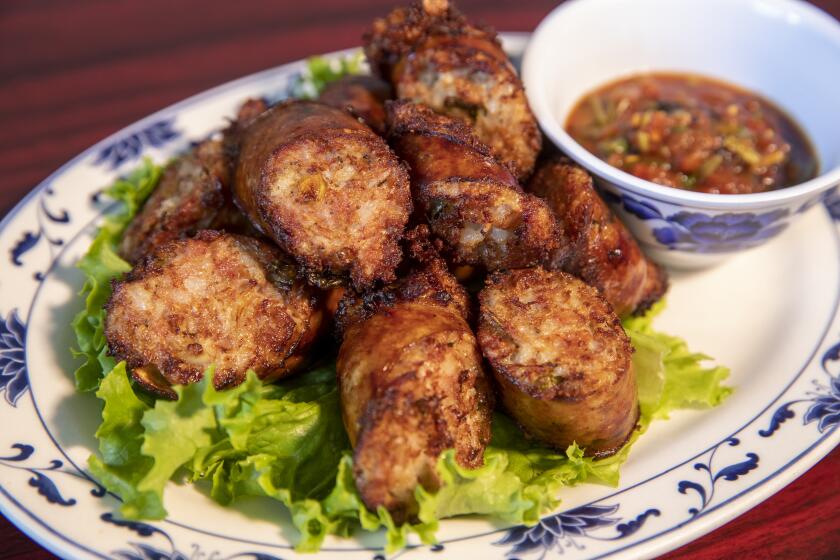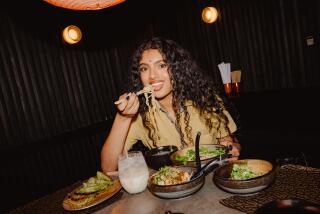The king ate sticky rice: Cooking, past and present, in Luang Prabang, Laos
LUANG PRABANG, Laos — It was 1974, and American bombs had only recently stopped falling here. In less than a year, Pathet Lao rebels would take over the entire country, establishing a communist dictatorship that exists to this day. Next door, and in only a matter of months, North Vietnamese forces would seize Saigon, and the Khmer Rouge would commence its repressive, genocidal rule of Cambodia.
It was a turbulent, terrifying time for many people in Southeast Asia, but British diplomat Alan Davidson and the crown prince of Laos were talking food. Specifically: fish.
Davidson, a burgeoning food writer, was interested in the edible fish of the Mekong River, and had sought the crown prince’s thoughts on the topic. Before leaving, Davidson asked for sources of fish-based recipes, and the crown prince paused, “as though searching his memory,” Davidson would later recall, and returned with two French-era notebooks.
Laotian fish curry, spiced with fresh and dried chiles and curry powder, is a simple, elegant dish that gets its richness from coconut milk.
He explained that they contained the handwritten recipes of the late chef of the (soon-to-be-defunct) Kingdom of Laos, a man called Phia Sing. Sensing their value, Davidson had them photocopied and translated, and in 1981, a little-known yet classic cookbook was born: “Traditional Recipes of Laos: Being the Manuscript Recipe Books of the Late Phia Sing, From the Royal Palace at Luang Prabang, Reproduced in Facsimile and Furnished With an English Translation.”
In later years, Davidson would go on to write “The Oxford Companion to Food,” one of the more influential books on the topic of food in the English-speaking world, and Phia Sing would have his literal dying wish realized: With the publication of “Traditional Recipes of Laos,” his recipes had been recorded for posterity. Today, this unlikely collaboration serves as an influence for chefs and restaurateurs in Luang Prabang, the tourist destination in northern Laos, as well as a glimpse into a lost, almost fantastical culinary world.
I first visited Luang Prabang in 1998, a century after Phia Sing was thought to have been born there. Laos had only just opened its doors to tourism, and I suspect that little had changed since Phia Sing’s time. Located on a finger of land at the confluence of the Mekong and Khan rivers and ringed by mountains, Luang Prabang was dusty, sleepy, remote (we reached the town via a two-day boat trip along the Mekong River from Thailand) and staggeringly beautiful: The town’s abundance of Buddhist temples and French-era architecture meant that, in 1995, UNESCO designated it a World Heritage site. Then as today, a walk through the town’s morning market, which unfolds outdoors along narrow alleyways, revealed items that Phia Sing would have been intimately familiar with: immense, prehistoric-looking catfish and graceful sheatfish; traffic-cone-orange mushrooms and stout wedges of bamboo; resplendent but flavorless torch ginger flowers and a dark, gnarled, peppery-tasting vine known as sakhaan; jungle animals and bundles of dried buffalo skin.
In “Traditional Recipes of Laos,” these ingredients find their way into dishes still eaten in Luang Prabang today, such as ua no mai and ua sikhai, shoots of bamboo or stalks of lemongrass stuffed with seasoned minced pork before being battered and deep-fried; or jaew bong, a chili-based dip that includes strips of dried buffalo skin. Ping kha fahn, a complicated recipe for grilling the haunch of a barking deer, is a nod to the royal palace’s proximity to the jungle, while nua ngua khua som, a stir-fry of beef that includes butter and canned tomatoes, shows a clear French influence.
Laotian cuisine can be hard to find, but it’s certainly worth the search. Get your Lao food fix at these four places in and around Los Angeles.
I discovered “Traditional Recipes of Laos” a few years after my first visit, yet for me, the book was more than just a list of recipes. It was a snapshot of a fascinating culinary world, one that effortlessly intertwined mountainous jungle and royal palace, smoky grills and sauté pans, the eggs of paa buek (the world’s largest freshwater fish) and tins of crab meat. Even the way Phia Sing described ingredients (“a piece of beef the size of a hand,” “minced pork, the quantity the size of a duck’s egg”) conveyed a culinary sensibility that was evocative and beautiful.
I wanted a link to this world, and so I went back to Luang Prabang to seek out one of the few remaining people to have been directly involved in it: Chanthanom Chaleunsinh, the daughter of Phia Sing.
“He was a strict man!” Chanthanom recalled when we met. “He would tell you if he wasn’t happy with something.” In 1976, Chanthanom — who was born in Luang Prabang in 1932 — and her family were forced out of the palace by the communists, and since then they’ve lived a few doors down, in a French-era building that today houses a travel agency. They were lucky to have avoided the fate of others linked to the royal family: sent to re-education camps or cave-bound prisons in the far north of the country.
As we chatted, family members brought out old, dusty photos of Phia Sing. In one image, taken in Hanoi, in 1930, he looks young and cocky. In another, taken at a royal wedding (during which he was undoubtedly burdened with responsibility), he looks severe. His almost wedge-like head, which I recognized from an illustration in “Traditional Recipes of Laos,” is easy to spot, and is an attribute he passed along to his daughter.
Chanthanom told me that the king loved dishes made with paa daek, the pungent, salty fermented fish paste that Laotian people can’t do without and that the rest of us struggle with.
“The king ate sticky rice,” she said of the staple but rustic local carb, another example of his devoutly Laotian tastes. “He only ate long-grained rice when guests came.”
I asked what her father’s favorite dish was, and she said or lam sin kuay, an herbaceous stew of buffalo that is one of the recipes included in the cookbook.
“Or lam is a very traditional dish, specific to the north of Laos, especially Luang Prabang,” explained Joy Ngeuamboupha, the chef/owner of Tamarind, a restaurant in Luang Prabang, whom I tracked down to talk about the dish. “It’s so Lao that we couldn’t not serve it.”
I asked Joy’s staff to make or lam sin kuay as described in the book, and the soup was, frankly, one of the most delicious things I’ve eaten in years: downright peppery from the addition of sakhaan, thick from grilled, pounded eggplant (a particularly Luang Prabang cooking technique), fragrant from dill (another very Luang Prabang touch) and meaty from dried, grilled strips of buffalo.
“Phia Sing’s recipes are a reflection of Lao traditional cuisine,” explained Joy, a native of Luang Prabang province. “When I read his recipes, it reminds me of how we used to cook at home when I was young.”
Yet Phia Sing was, of course, cooking in a royal palace, and many of his recipes go in a direction that doesn’t reflect Laotian-style home cooking. Several of his curry dishes include coconut milk, an ingredient associated more with the Thai kitchen. And while the majority of Laotian dishes are grilled, steamed or boiled, Phia Sing has a fondness for frying. Were these local recipes adapted for a king? Phia Sing’s interpretation of the royal court cooking of neighboring Thailand? Or simply his inventions? Most likely they were all of these things, and those cooking from “Traditional Recipes of Laos” have to reckon with this ambiguity.
“I don’t try to interpret the recipes, I don’t want to change them,” explained Sebastien Rubis, culinary director of the Rosewood Luang Prabang. We were chatting at the resort, and I appeared to have interrupted the chef from some gardening, his wide-brimmed hat matching the blue-green of his eyes. “But to cook from this book, I have to test each dish three or four times — the amounts and techniques aren’t exact. I always have my Lao staff give feedback.”
Born in France but having spent time in Laos since the early 2000s, Rubis is an officially designated chef ambassador of the country, and his menu at the Rosewood includes several dishes described by Phia Sing, including kalee paa, a coconut milk curry with freshwater fish.
“We do curries from the book, but they’re not about seasoning; the flavor comes from the main ingredient,” he told me. Indeed, the dish is mild, creamy and rich — subtle attributes I wouldn’t normally associate with Laotian cooking. It’s impossible to know exactly how kalee paa would have tasted when Phia Sing made it, but Rubis’ interpretation of the curry, especially when eaten in one of Luang Prabang’s most expensive hotels, somehow just felt right to me.
Perhaps the clearest manifestation of Phia Sing’s palace cooking is his recipe for yam yai, a type of Thai/Laotian salad. Among the 24 ingredients are crab meat (canned, as would have been necessary in landlocked Luang Prabang) and dried squid, items that would have been incredibly rare and expensive in Luang Prabang a century ago.
“The dish has a mix of ingredients and flavors that we could work with,” explained Bee Satongun, the chef behind Paste, a Luang Prabang restaurant that serves an interpretation of Phia Sing’s yam yai. I asked her what adjustments she made from Phia Sing’s recipe.
“I added salted egg yolk to make the dressing creamier and to add umami, and I added a bit of sugar to balance the flavors,” the Thai-born chef said.
I was presented with her take on yam yai, and besides being drop-dead gorgeous, it was delicious and intricate, seemingly touching on just about every taste and texture one might associate with Southeast Asian cooking (frequent air links between Luang Prabang and Bangkok mean that Phia Sing’s yam yai can finally include fresh crab meat). In the dish, I could see its local roots, its modern flourishes and the chef’s influence all at the same time. It struck me as something both old and new, simple and decadent, city and jungle, and I couldn’t help but think that Phia Sing would have approved.
More to Read
Eat your way across L.A.
Get our weekly Tasting Notes newsletter for reviews, news and more.
You may occasionally receive promotional content from the Los Angeles Times.











